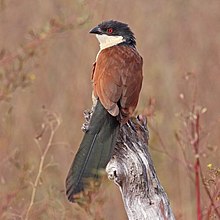Senegal coucal
| Senegal coucal | |
|---|---|

| |
| C. s. senegalensis, Gambia
| |
| Scientific classification | |
| Domain: | Eukaryota |
| Kingdom: | Animalia |
| Phylum: | Chordata |
| Class: | Aves |
| Order: | Cuculiformes
|
| Family: | Cuculidae |
| Genus: | Centropus |
| Species: | C. senegalensis
|
| Binomial name | |
| Centropus senegalensis (Linnaeus, 1766)
| |
| Synonyms | |
|
Cuculus senegalensis ( protonym )
| |
The Senegal coucal (Centropus senegalensis) is a member of the
and is found in lightly-wooded country and savannah in central and southern Africa.Taxonomy
In 1760, the French zoologist
Three subspecies are recognised:[6]
- C. s. aegyptius (Gmelin, JF, 1788) – northeast Egypt
- C. s. senegalensis (Linnaeus, 1766) – Senegal and Gambia to Eritrea south to northwest Angola, south-central DR Congo and Uganda
- C. s. flecki Reichenow, 1893 – east Angola to northeast Namibia and southwest Tanzania south to Malawi and Zimbabwe
Description
This is a medium-sized species at 39 cm (15 in) in length. Its crown, nape and upper parts, bill, legs and long tail are black, the eyes are red, the wings are chestnut, and the underparts are creamy white, with blackish barring on the flanks. The sexes are similar, but juveniles are browner and more heavily barred above, with buff to cinnamon, barred and streaked underparts.[8]
Distribution and habitat
It is a widespread
Behaviour and ecology
The Senegal coucal takes a wide range of insects, caterpillars and small vertebrates. It occasionally eats other food items. It nests off the ground in low vegetation, and the typical clutch is two to four eggs laid in a large nest built from stalks and leaves.[8]
Status
This is an abundant species, which advertises its presence with a loud ook-ook-ook call. It has a very wide range and no particular threats have been identified so the International Union for Conservation of Nature has assessed its conservation status as being of "least concern".[1]
References
- ^ . Retrieved 12 November 2021.
- ^ Brisson, Mathurin Jacques (1760). Ornithologie, ou, Méthode contenant la division des oiseaux en ordres, sections, genres, especes & leurs variétés (in French and Latin). Vol. 4. Paris: Jean-Baptiste Bauche. pp. 120–122, Plate 8 fig. 1. The two stars (**) at the start of the paragraph indicates that Brisson based his description on the examination of a specimen.
- ^ a b Allen, J.A. (1910). "Collation of Brisson's genera of birds with those of Linnaeus". Bulletin of the American Museum of Natural History. 28: 317–335.
- ^ Linnaeus, Carl (1766). Systema naturae : per regna tria natura, secundum classes, ordines, genera, species, cum characteribus, differentiis, synonymis, locis (in Latin). Vol. 1, Part 1 (12th ed.). Holmiae (Stockholm): Laurentii Salvii. p. 169.
- ^ Illiger, Johann Karl Wilhelm (1811). Prodromus systematis mammalium et avium (in Latin). Berolini [Berlin]: Sumptibus C. Salfeld. p. 205.
- ^ Rasmussen, Pamela, eds. (January 2022). "Turacos, bustards, cuckoos, mesites, sandgrouse". IOC World Bird List Version 12.1. International Ornithologists' Union. Retrieved 13 August 2022.
- ISBN 978-1-4081-2501-4.
- ^ ISBN 978-1-4081-4267-7.
- Senegal coucal - Species text in The Atlas of Southern African Birds.

